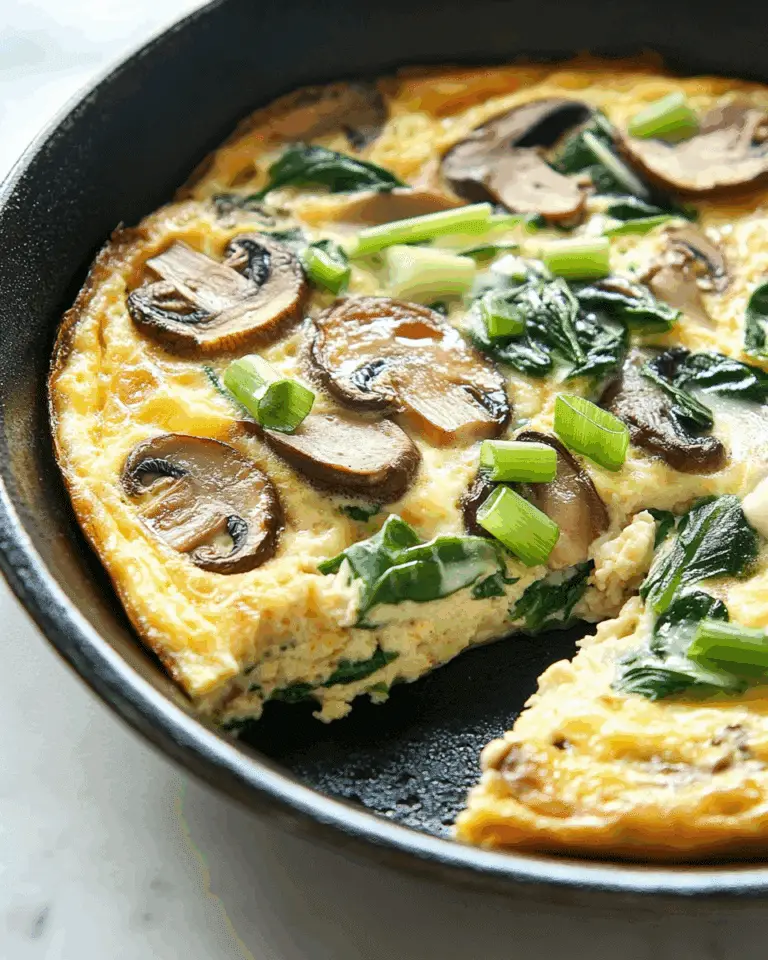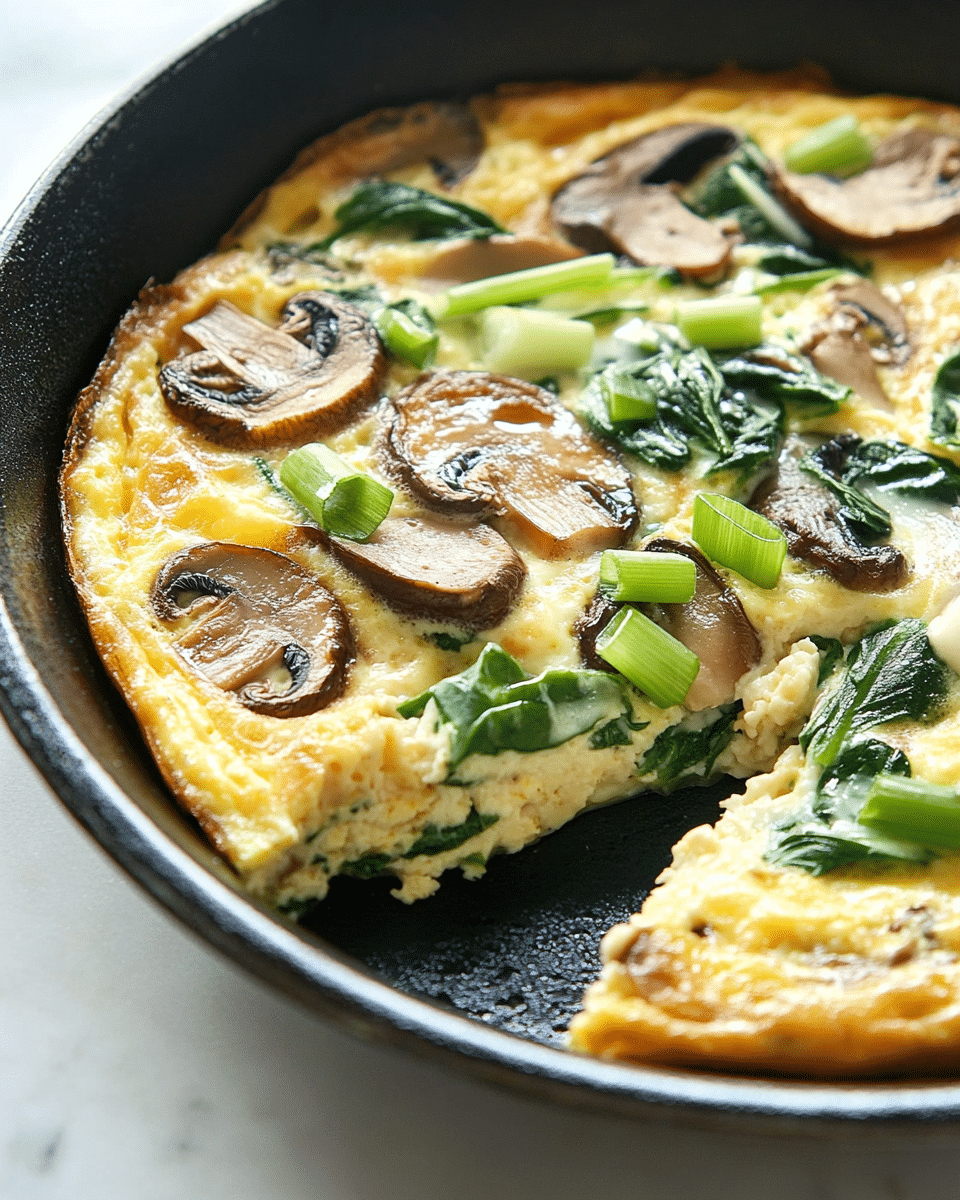A vibrant, protein-packed frittata that combines earthy mushrooms, nutritious spinach, and savory eggs for a versatile meal perfect for any time of day. This simple yet flavorful dish comes together in under 30 minutes, making it ideal for busy mornings or a quick dinner option.
Why You’ll Love This Recipe
This mushroom and spinach frittata is a game-changer for your meal rotation. It’s incredibly versatile—perfect for breakfast, brunch, lunch, or a light dinner. The combination of protein-rich eggs with nutritious vegetables creates a satisfying meal that’s both healthy and delicious.
You’ll appreciate how customizable this recipe is, allowing you to adapt it based on what’s in your refrigerator. It’s also naturally gluten-free and can easily be made dairy-free by omitting the cheese. The frittata reheats beautifully, making it an excellent choice for meal prep and busy weekdays.
Beyond its practicality, this frittata delivers impressive flavor with minimal effort. The earthy mushrooms, fresh spinach, and aromatic garlic create a sophisticated taste profile that will make you feel like you’re dining at a gourmet brunch spot—all from the comfort of your home.
Ingredients
(Tip: You’ll find the full list of ingredients and measurements in the recipe card below.)
Eggs form the foundation of any frittata, providing structure, protein, and a neutral canvas for the other flavors to shine. For best results, bring your eggs to room temperature before whisking to achieve maximum volume and fluffiness.
Mushrooms add an earthy, meaty quality to the frittata. They release moisture as they cook, which gets absorbed back into the mushrooms when browned properly, intensifying their rich umami flavor. Cremini or portobello varieties work exceptionally well here.
Spinach contributes essential nutrients and a lovely color contrast. It wilts down significantly during cooking, so don’t be afraid to add what initially looks like too much. Fresh spinach works beautifully, but frozen can be used in a pinch—just be sure to thaw and thoroughly drain it first.
Zucchini brings a delicate flavor and additional moisture to the frittata. Slicing it thinly ensures it cooks quickly and integrates well with the other ingredients.
Onion provides an aromatic base that builds depth of flavor. Take the time to sauté it properly until translucent to release its natural sweetness.
Cheese is optional but adds wonderful richness and helps bind the frittata together. Cheddar offers sharpness, mozzarella contributes meltability, and goat cheese provides tangy creaminess.
Olive oil is ideal for sautéing the vegetables because of its flavor and higher smoke point compared to butter.
Garlic introduces an aromatic punch that elevates all the other flavors. Mince it finely to ensure it distributes evenly throughout the dish.
Salt and pepper are essential for bringing out the natural flavors of the eggs and vegetables. Season thoughtfully at each stage of cooking.
Red pepper flakes add a gentle heat that brightens the dish without overwhelming it. They’re optional but highly recommended for anyone who appreciates a subtle kick.

Directions
- Prep Your Ingredients: Slice the zucchini thinly, finely chop the onion, clean and slice the mushrooms, and mince the garlic. If using fresh spinach, rinse and pat dry. If using frozen spinach, thaw completely and squeeze out excess moisture.
- Sauté the Vegetables: Heat an oven-safe skillet over medium heat and add olive oil. Sauté onions for 2-3 minutes until translucent, then add garlic and cook for another minute. Add mushrooms and cook for about 5 minutes until golden brown. Add zucchini and cook for 3-4 minutes until slightly softened. Finally, add spinach and cook until wilted or heated through. Season the vegetable mixture with salt, pepper, and red pepper flakes if using.
- Prepare the Eggs: In a large bowl, whisk the eggs until combined and slightly frothy. Season with a pinch of salt and pepper. If using cheese, stir half of it into the egg mixture.
- Combine and Cook: Ensure the vegetables are evenly distributed in the skillet, then pour the whisked eggs over them. Gently stir once to allow the eggs to flow between the vegetables. If using cheese, sprinkle the remaining half over the top.
- Finish Cooking: Reduce heat to low and let the frittata cook on the stovetop for 3-4 minutes until the bottom sets. Preheat your broiler to high. Transfer the skillet to the oven and broil for 5-7 minutes until the top is golden and the eggs are fully set. Alternatively, bake in a 350°F oven for 10-12 minutes.
- Serve: Let the frittata cool slightly before sliding it onto a cutting board. Slice into wedges and serve with optional garnishes like fresh herbs or a dollop of Greek yogurt.
Servings and Timing
This recipe serves 4-6 people, depending on what else you’re serving with it. It takes approximately 25 minutes total to prepare and cook—10 minutes of preparation time, 5-7 minutes of stovetop cooking to set the base, and 5-7 minutes under the broiler (or 10-12 minutes in the oven) to finish cooking.
The frittata is substantial enough to be a complete meal, especially for breakfast or lunch, but can also be paired with a side salad, whole grain toast, or roasted potatoes for a more filling option.
Variations
Mediterranean Frittata: Add diced tomatoes, olives, and crumbled feta cheese for a Mediterranean twist. Finish with fresh basil after cooking.
Potato and Herb Frittata: Replace the zucchini with pre-cooked, diced potatoes and add fresh herbs like thyme, rosemary, and chives for a heartier version.
Spicy Southwest Frittata: Incorporate diced bell peppers and jalapeños with the mushrooms, and add black beans. Top with avocado slices and salsa after cooking.
Dairy-Free Option: Omit the cheese completely or substitute with nutritional yeast for a cheesy flavor without dairy.
Protein-Packed Version: Add cooked, diced chicken or crispy bacon bits to the vegetable mixture before adding the eggs.
Spring Vegetable Frittata: Substitute asparagus tips and peas for the mushrooms for a fresh, seasonal variation.
Leek and Gruyère Frittata: Replace the onion with sautéed leeks and use Gruyère cheese for a sophisticated flavor profile.
Storage/Reheating
Refrigerating: Allow the frittata to cool completely before storing. Wrap individual slices tightly in plastic wrap or place them in an airtight container. The frittata will keep well in the refrigerator for up to 4 days, making it an excellent option for meal prep.
Freezing: While eggs can sometimes change texture when frozen, frittatas freeze surprisingly well. Wrap individual portions tightly in plastic wrap and then aluminum foil, or place in freezer-safe containers. Label with the date and freeze for up to 2 months.
Reheating Refrigerated Frittata: For the best texture, reheat refrigerated frittata in a 350°F oven for about 10 minutes, or until warmed through. You can also reheat slices in a microwave at 50% power for 1-2 minutes, though the texture may be slightly softer.
Reheating Frozen Frittata: Thaw overnight in the refrigerator before reheating. For best results, unwrap and place on a baking sheet in a 350°F oven for 15-20 minutes. If reheating from frozen, add an additional 5-10 minutes to the cooking time.
Room Temperature Option: Frittata can also be enjoyed at room temperature, making it an excellent option for picnics or packed lunches. Just ensure it hasn’t been out of refrigeration for more than 2 hours for food safety.
FAQs
How do I know when my frittata is fully cooked?
The frittata is done when the edges are set and golden, the top is firm to the touch, and a knife inserted in the center comes out clean. The center should not jiggle when you gently shake the pan. Be careful not to overcook, as this can make the eggs rubbery.
Can I make this frittata ahead of time for a brunch party?
Absolutely! You can prepare the frittata up to a day in advance and refrigerate it. Serve it at room temperature or gently reheat in a 300°F oven until warmed through, about 15-20 minutes. This makes it perfect for stress-free entertaining.
What’s the difference between a frittata and an omelet?
While both are egg-based dishes, a frittata is cooked slowly over low heat and finished in the oven, resulting in a thicker, cake-like texture that’s sliced into wedges. An omelet is cooked quickly on the stovetop, folded over fillings, and served individually.
My frittata stuck to the pan. How can I prevent this?
Ensure your pan is well-seasoned if using cast iron, or use a good non-stick skillet. Add enough oil before cooking and make sure it coats the entire surface, including up the sides. Let the frittata set properly before attempting to remove it from the pan.
Can I use egg whites only for this recipe?
Yes, you can substitute whole eggs with egg whites. As a general rule, use two egg whites for each whole egg called for in the recipe. Note that the texture will be lighter and the flavor less rich without the yolks.
Why did my frittata turn out flat and dense?
This typically happens when the eggs are overbeaten or when the frittata is overcooked. Beat eggs just until combined and watch cooking time carefully. Also, make sure your baking temperature isn’t too high, as this can cause the eggs to seize.
What’s the best pan to use for a frittata?
A 10-12 inch cast iron skillet is ideal because it conducts heat evenly and can go from stovetop to oven. However, any oven-safe non-stick skillet will work well. Avoid pans with plastic handles that aren’t oven-safe.
Can I add meat to this frittata?
Definitely! Pre-cooked meats like crumbled sausage, diced ham, or bacon bits make excellent additions. Add them to the vegetable mixture before pouring in the eggs to ensure they’re evenly distributed.
My frittata deflated after coming out of the oven. Is this normal?
Some deflation is normal as the frittata cools. To minimize this, avoid overmixing the eggs (which incorporates too much air) and make sure your frittata is fully cooked before removing it from the oven.
How can I make this frittata more filling for a dinner meal?
Serve larger portions alongside roasted potatoes, a hearty salad, or crusty bread. You can also increase the protein content by adding cooked meat or legumes to the frittata itself, or serve with a side of yogurt or avocado for additional healthy fats.

Conclusion
The Mushroom and Spinach Frittata is more than just a recipe—it’s a versatile cooking technique that opens up endless possibilities for quick, nutritious meals. Once you master this basic formula, you’ll find yourself reaching for it regularly, customizing it based on what’s in season or available in your refrigerator.
What makes this frittata truly special is its ability to transform simple ingredients into something greater than the sum of its parts. The combination of earthy mushrooms, vibrant spinach, and fluffy eggs creates a dish that’s equally at home on a weekday breakfast table or at a sophisticated weekend brunch.
Beyond its delicious taste, this frittata represents smart cooking—economical, efficient, and adaptable. It helps reduce food waste by utilizing vegetables that might be past their prime, stretches expensive proteins through multiple servings, and provides make-ahead convenience for busy schedules.
Whether you’re cooking for yourself, your family, or guests, this Mushroom and Spinach Frittata delivers crowd-pleasing flavor with minimal effort. It’s a recipe worth adding to your regular rotation and a technique worth mastering for culinary confidence and creativity.
Print
Mushroom and Spinach Frittata
Mushroom and Spinach Frittata is a savory, protein-packed breakfast recipe that combines eggs, mushrooms, spinach, and other wholesome ingredients, making it versatile, customizable, and easy to prepare.
- Total Time: 20–24 minutes
- Yield: 4 servings
Ingredients
- 6 large eggs
- 1 cup of mushrooms (cremini or portobello work best for a rich flavor)
- 1 cup of spinach (fresh or frozen, but thaw and drain frozen spinach before using)
- 1 medium zucchini, sliced thin
- 1 small onion, finely chopped
- ½ cup of shredded cheese (optional; use cheddar, mozzarella, or goat cheese)
- 1 tablespoon of olive oil
- 2 cloves of garlic, minced
- Salt and pepper, to taste
- A pinch of red pepper flakes (optional for a little heat)
- Optional Garnishes: fresh herbs like parsley or chives, a dollop of sour cream or Greek yogurt
Instructions
- Prep Your Ingredients: Thinly slice the zucchini, finely chop the onion, clean and slice the mushrooms, prepare the spinach (rinse fresh or thaw frozen), and mince the garlic.
- Sauté the Vegetables: Heat an oven-safe skillet over medium heat, add olive oil, and sauté the onion for 2–3 minutes. Stir in garlic for 1 minute, then add mushrooms and cook for 5 minutes until golden brown. Add zucchini and sauté for 3–4 minutes. Add spinach, letting it wilt or heat through, and season with salt, pepper, and red pepper flakes.
- Whisk the Eggs: In a bowl, whisk the eggs until frothy. Add a pinch of salt and pepper. Stir in half of the shredded cheese if using.
- Combine Eggs and Vegetables: Evenly distribute the sautéed vegetables in the skillet. Pour the whisked eggs over and gently stir once. Sprinkle the remaining cheese on top.
- Cook and Bake: Reduce the skillet heat to low, letting the frittata cook for 3–4 minutes until the bottom sets. Preheat the oven’s broiler and transfer the skillet to the oven. Broil for 5–7 minutes until the top is golden and eggs are set, or bake at 350°F (175°C) for 10–12 minutes if no broiler is available.
- Serve and Enjoy: Let the frittata cool for a few minutes. Loosen the edges with a spatula, slide it onto a cutting board, slice into wedges, and serve with optional garnishes like parsley, chives, sour cream, or Greek yogurt.
Notes
- Don’t overmix the eggs to ensure a fluffy texture.
- Use an oven-safe skillet, such as cast iron, for seamless stovetop-to-oven cooking.
- Customize the recipe by adding other vegetables like bell peppers, tomatoes, or broccoli.
- Make it dairy-free by skipping the cheese or using a plant-based cheese substitute.
- Prep Time: 10 minutes
- Cook Time: 10–14 minutes
- Category: Breakfast
- Method: Broil and Stove Cooking
- Cuisine: American
- Diet: Gluten Free
Nutrition
- Serving Size: 1/4 frittata
- Calories: 180
- Sugar: 2g
- Sodium: 300mg
- Fat: 12g
- Saturated Fat: 4g
- Unsaturated Fat: 8g
- Trans Fat: 0g
- Carbohydrates: 5g
- Fiber: 2g
- Protein: 12g
- Cholesterol: 210mg


